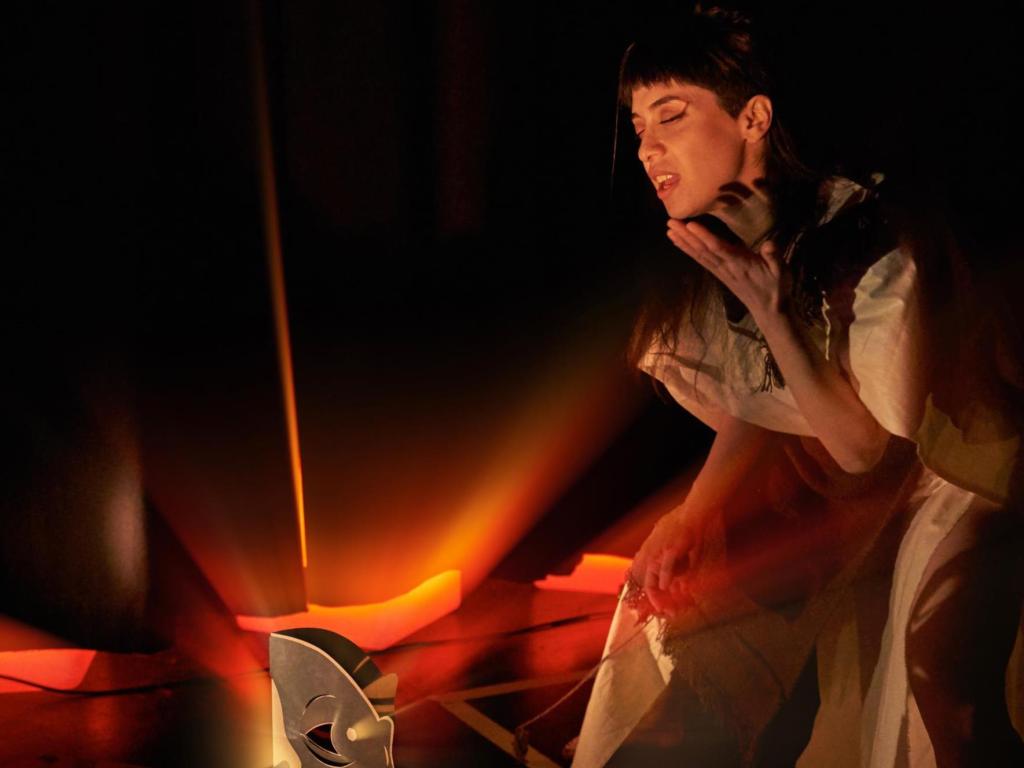Sheshgelani in The Birds Conference; image supplied.
The Conference of the Birds occupies the same position in the Iranian poetic tradition that Beowulf or Ulysses does in English. It’s rich in the symbolism and imagery that are the hallmarks of the Naghali, Pardeh-dari, Pardeh-khaani, Ghavali and Shahnameh-khaani forms of Iranian storytelling, a tradition that Elnaz Sheshgelani draws heavily on in her interpretation of this famous poem. In The Bird Conference Sheshgelani has created a rich visual tapestry that takes an ambitious and experimental approach to produce a non-linear narrative that feels as if you’ve strayed into a stranger’s dream.
The original poem tells of a great gathering of birds who flock together in order to choose their first king. They are unable to agree and instead choose a smaller group to venture out in search of a mythical bird, greater than all others who they will return and crown as their king. The poem is noted for its expert use of metaphor and wordplay in exploring the innate flaws of humanity and how these flaws define our relationship with the divine. Indeed, each of the birds who set out are named after a human flaw and the mythical being after the collective.
Elnaz’s approach is a distinctly modern one and she appears keen to abandon conventional narrative structures in favour of a more expressionist mode of storytelling. This approach extends to light and sound, both of which were as much in-direct narrative devices as they were separate elements. The soundscape, provided by Clinton Green, used a similarly unconventional array of instruments to craft a stream-of-thought, conversational style of music. Along with the decoupage style projections that replaced the static tapestry, which usually form the background to Naghali storytelling, it rounded out a thoroughly provocative set up for a work that is considered a classic.
It is weighty subject matter and to tackle such a complex narrative so steeped in tradition in this manner was never going to be easy. Then again the strength of movements like expressionism, surrealism and the avant-garde are in no small part about breaking down the forms we hold as sacrosanct. In the work of artists like Louis Brunel and Pina Rauch we see how experimental art forms can succeed spectacularly. So does Elnaz’s approach work?
At some points it does and at others it doesn’t. The vivid projections and puppets really did make you feel as if you had gone to sleep and woken up inside another person’s head, whose thoughts were yet to go through the translation of conventional communication. This novel experience was a lovely one. In order to sustain the deconstructed Naghali approach, with its abandonment of narrative form, though it needed something else to replace the expected structure to prevent it from feeling self-indulgent and disconnected. Something unsettling, something raw, something that the limits of form prevent from being communicated, but this was not something that The Bird Conference is able to achieve yet.
As one of the directors, Lloyd Jones, mentioned in his introduction, The Bird Conference is still a work in progress but it will be very interesting to see where it ends up. It is full of potential.
Rating: 3 stars out of 5
Naghal (Storyteller) Elnaz Sheshgelani
Puppets, Masks and Set Design Elnaz Sheshgelani
Music Clinton Green
Light Manipulator Simon Fisher
La Mama Theatre
2 – 13 September





